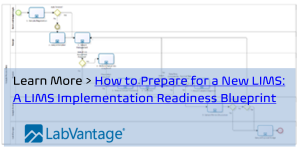 As a growing number of labs make digital transformation a priority, there’s often a lot of talk about “using data to improve the organization.”
As a growing number of labs make digital transformation a priority, there’s often a lot of talk about “using data to improve the organization.”
In fact, we’re guilty of it! We’ve shared real-world applications for AI/ML (here and here, for example) and spoken of the power of analytics to transform organizations. We (and just about everyone else) fundamentally understand that data – and the ability to mine it for insights – is already a core growth driver for scientific labs.
Yet many labs are putting the proverbial cart before the horse by attempting to dive straight into analysis without putting a clearly defined data strategy in place.
Here are five essential components of successful data strategies every lab should ensure they have established before trying to use data to drive growth and improvement.
1. Clear Objectives
This may sound like a no-brainer, but many labs have only a vague notion of what they want to accomplish when they set out to mine their data for insights. It’s not enough to want to “make the lab more efficient and profitable.” You need to set specific, quantifiable goals that are based on the real-world research your lab is actually performing (or wants to perform).
This step is key for several reasons. First, it helps your lab to understand what types of data to collect and measure before moving on to analysis. Specifically defined objectives help you identify the necessary benchmarks and key performance indicators that will help you define progress and success.
2. Data Integration
Before data can be analyzed successfully, it needs to be easily accessible to the right people at the right time. The challenge here is that data comes in many different forms, often stored in incompatible systems and formats — everything from systems lacking an interface to hand-written notebooks.
Integrating these “data silos” in a logical and comprehensible way is key to ensuring that meaningful analysis can be performed. Ideally, an integrated data infrastructure should not only ensure the accessibility of existing data but should streamline the collection of new data wherever possible.
3. Broad Data Team Diversity
Your lab’s strategy will impact everyone who interacts with your data, from collection and organization to analysis, experiments, and client interactions. Each key role in your lab utilizes data in their own unique way. As such, it’s essential for each of these roles to have a voice on your data management team.
Everyone in your organization stands to benefit from a diverse team approach. To begin with, each type of team member will bring unique insights based on how they use data. Equally important, however, is that diverse participation enables each key element of your workforce to feel like they can influence the strategy, increasing the likelihood of buy-in across your organization.
4. Efficient Governance
Governance covers many critical aspects of your data, including privacy, security, compliance and access permissions. Managing it efficiently requires close attention to two key elements:
 People — Who’s in charge of what, and who needs to be accountable for ensuring proper data management? Who has access?
People — Who’s in charge of what, and who needs to be accountable for ensuring proper data management? Who has access?
- Technology — How do LIMS, ELN, LES, instruments and other technological resources help to ensure data integrity, security and compliance while streamlining collection, storage, analysis and other uses? Can the lab operate more efficiently by automating or streamlining aspects of your data strategy by using tools built into the system?
5. The Ability to Evolve
Your lab’s needs and goals are likely to change over time and your data strategy will need to change with them. Creating your strategy won’t be a “once-and-done” affair. You’ll need to regularly revisit and reevaluate your strategy to stay current with your lab’s growth, serve changing customer needs, and take advantage of new opportunities as they arise.
Where to Learn More
A robust data strategy is a critical part of any lab’s digital transformation. To explore the full impact and advantages your lab can achieve, download our free white paper: Navigating the Digital Transformation Journey. It’s packed with practical advice to help you plan your own transformative journey.
Resources
White Paper
Videos & Podcasts
- AI Driven Labs – The Revolution Has Begun (podcast)
- Explore, Analyze, Visualize Your Data with LabVantage Analytics
Brochure
From the Blog
- Integrating Analytics with Your LIMS Platform
- Breaking Silos, Structuring Data and Bringing Decision-Making Informatics into the Lab
- Meeting the Challenges of Modern Data Management
Articles



